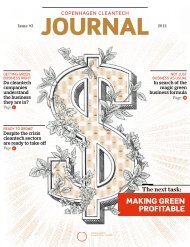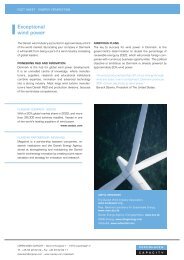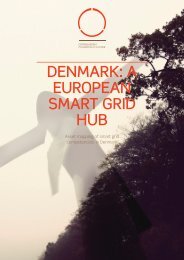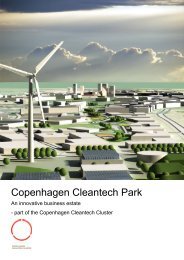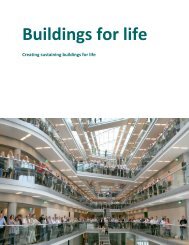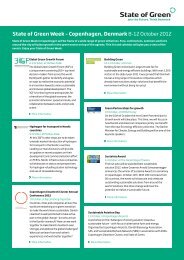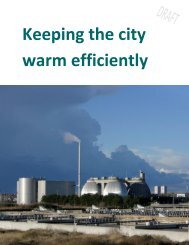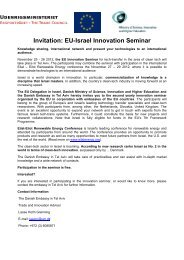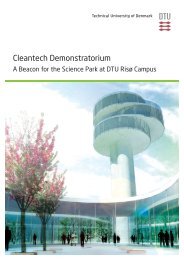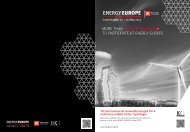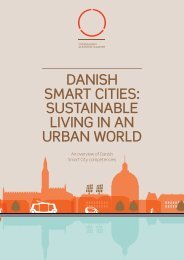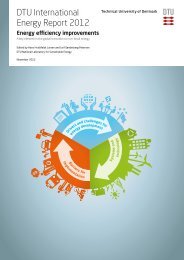Future low carbon energy systems - Copenhagen Cleantech Cluster
Future low carbon energy systems - Copenhagen Cleantech Cluster
Future low carbon energy systems - Copenhagen Cleantech Cluster
You also want an ePaper? Increase the reach of your titles
YUMPU automatically turns print PDFs into web optimized ePapers that Google loves.
5System aspectsto renewable generators; similar capabilities are required ofconventional generators to ensure that the system will continueto operate if one generating unit fails.farm5.1.3 Black start and isolated operationAnother fault mode arises when part of the grid becomesisolated from the main synchronous system. If the isolatedarea is able to control its own frequency and voltage, a blackoutcan be avoided and the reliability of the power systemimproves. If the part of the system that is isolated is dominatedby renewable and decentralised generation, then thecontribution of these generators to the control of frequencyand voltage can be the key to avoiding substantial load sheddingor even a blackout.If a blackout cannot be avoided, it is important to re-start thesystem as soon as possible afterwards. This “black start” processcan be supported by renewable and distributed generation,provided that these generators support frequency andvoltage control. In cases like these, the control dynamics ofthe power system can be very important. Risø DTU has runa number of simulations of wind farm models connected tosimplified grid models, to test the ability of wind farm powercontrollers to provide the necessary grid support [2].5.1.4 ReliabilityThe reliability of wind power is an issue in normal operationas well as under fault conditions. Wind farm ownersmeasure reliability in terms of their ability to sell power. Inthis case, a simple measure of reliability is the ratio of actualproduction to the <strong>energy</strong> available according to wind speeddata and turbine power curves, taking into account failuresin wind turbines and the grid itself.From the point of view of the system operator, reliability is mainlyabout the risk that all or some of the predicted wind power willnot be produced. Factors affecting this measure of reliability are:forecasts; these generally cannot be avoided, but canprobably be reducedturbines, production of individual turbine drops suddenlyfrom rated power to zeroto the transmission systemAt the power system level, reliability is about the total performanceof all the wind farms in the system, not about failuresof individual turbines or wind farms.Another reliability issue is whether the power system canhandle peak loads. With large-scale renewable generation inthe system, many thermal power plants will have to operateat reduced load factors. This may reduce investment in newthermal power plants, which in turn might lead to problemswith system adequacy at peak loads when the amount of renewablegeneration is <strong>low</strong>.A major research challenge is to build reliability models thatcombine general reliability factors, such as grid failures, withfactors specific to wind power, such as wind forecast errorsand cut-outs at high wind speeds.5.2 Grid planning and developmentOne of the biggest challenges to the reliable integration oflarge amounts of wind <strong>energy</strong> in power <strong>systems</strong> is powertransmission. Areas with good wind potential are often locatedfar from load centres. To manage variable <strong>energy</strong> productionon a large geographic scale, the grid infrastructureand interconnections should be extended and reinforced.As the first phase of the European Wind Integration Study(EWIS) 1 concluded, without grid reinforcement Europe willnot be able to reach its targets for renewable <strong>energy</strong> [3].Large-scale integration of renewable <strong>energy</strong> requires a pan-European transmission network for effective cross-borderpower trading and mutual support for security and qualityof supply. There is a need for advanced simulation and analysistools, combined with dynamic calculations for the interconnectedEuropean power system. Planning tools shouldbe developed for the design of efficient grids.Risø DTU is taking part in several projects aiming to developsoftware tools and use them for grid integration studies. Oneof these is TradeWind [4], an EU-funded project which aimsto provide technical and economic justification for strategicdecision-making on the development of the EU’s grid andgeneration infrastructure [4].1 An initiative established by the TSO associations of the European transmission system operators (such as UCTE and ETSO) in collaboration withthe European Commission.34 Risø Energy Report 7




